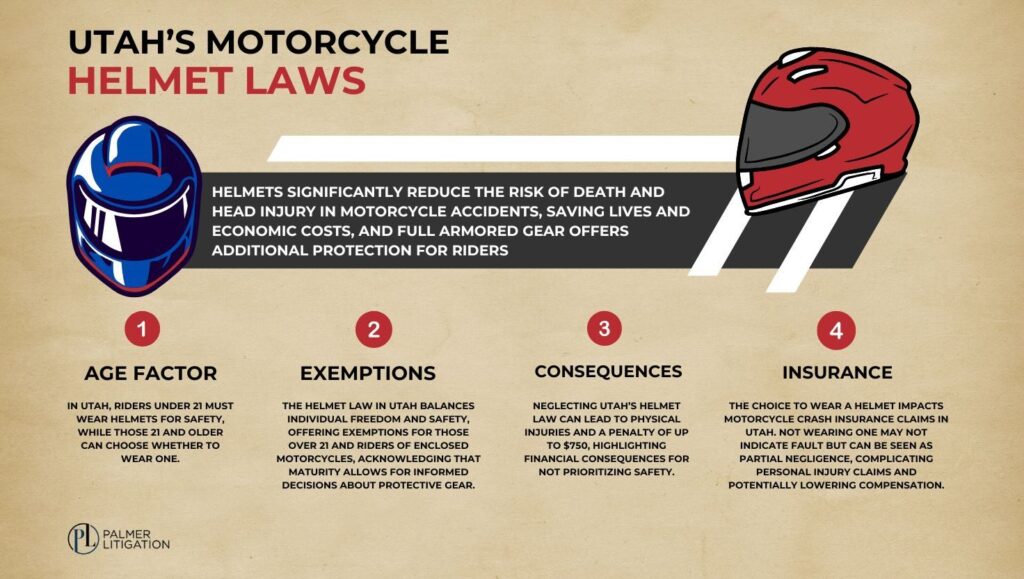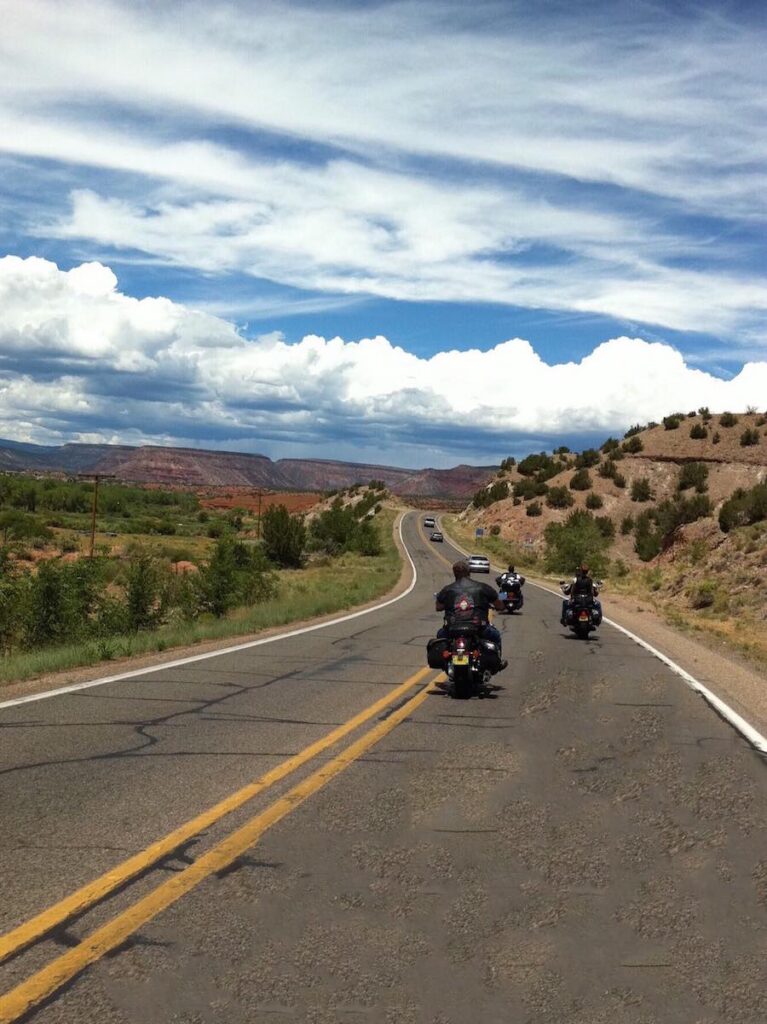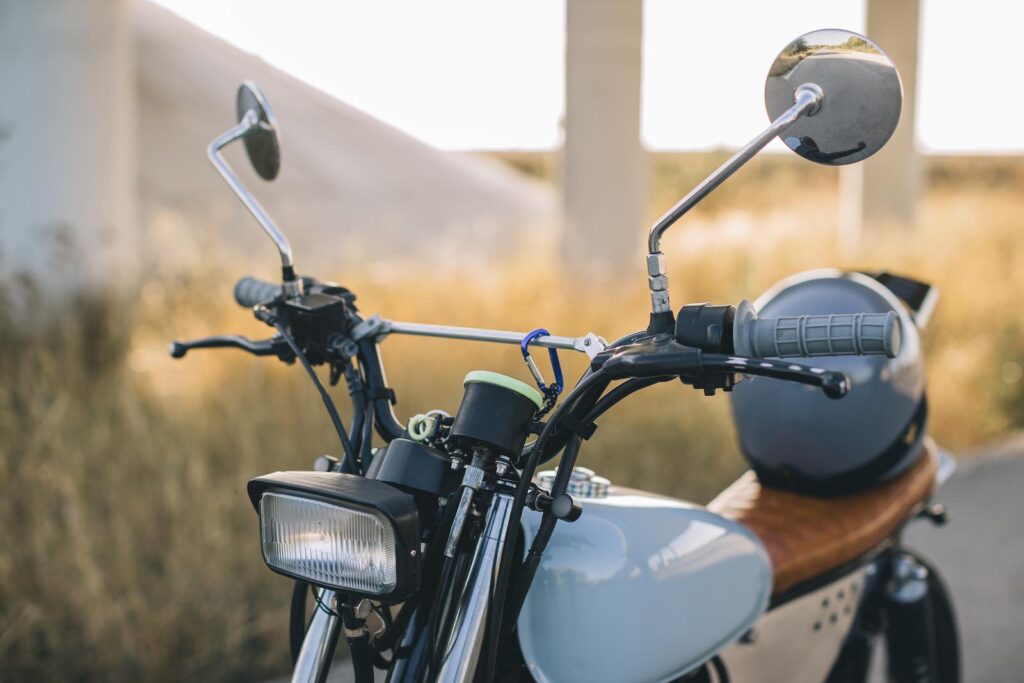If you’re riding a motorcycle in Utah, do you need a helmet? Utah’s helmet law mandates that all motorcyclists and passengers under 21 years old wear DOT-approved helmets. For those 21 and over, helmets are optional, but the decision weighs heavily on safety considerations. This article breaks down the Utah helmet law, examining age requirements, exceptions, safety impacts, and other legal nuances riders should know.
Key Takeaways
- Utah law requires all motorcycle riders and passengers under 21 to wear DOT-approved helmets, with optional use for those 21 and over, despite the raised age limit from 18 to 21 since 2017.
- Helmets significantly reduce the risk of death and head injury in motorcycle accidents, saving lives and economic costs, and full armored gear offers additional protection for riders.
- Non-compliance with helmet laws can result in fines, and riding without a helmet may impact insurance claims and personal injury compensation, underscoring the benefits of legal assistance from personal injury lawyers.
Navigating Utah’s Helmet Regulations
If you’re considering hopping on a motorcycle in Utah and are not yet 21, remember that wearing a helmet is more than prudent—it’s mandatory. Under the partial helmet law of Utah, anyone under 21 who rides or travels as a passenger on a motorcycle must wear helmets conforming to the stringent safety criteria established by the Department of Transportation (DOT). The regulations may appear simple at first glance. Additional details concerning age requirements and potential exemptions are worth noting for all young motorcyclists.
The Age Factor in Helmet Requirements
In Utah, turning 21 isn’t just a milestone for celebration but also signifies a transition in your motorcycling journey. Before this age, wearing a helmet is mandatory, reflecting the vulnerability of younger riders and showcasing Utah’s dedication to safeguarding them. After crossing into the realm of those aged 21 or above, it becomes your prerogative whether to wear a helmet while riding.
The age limit defining this passage hasn’t always been set at 21. Back in 2017, legislators decided to raise the minimum age from 18 to promote safety among young adults—a step aimed at extending protection into early adulthood. Still important to keep in mind is that reaching beyond one’s twenty-first year does not eliminate inherent risks associated with riding bareheaded. Danger doesn’t vanish as one celebrates their legal coming-of-age ceremony with birthday cake candles flickering out.
Exemptions and Exceptions to the Rule
The helmet law in Utah may feel like an unwarranted constraint to those older and more careful, particularly for individuals over 21 or those cruising stylishly inside a motorcycle with an enclosed cab. The rule’s exemptions strike a compromise between individual liberty and safety concerns, acknowledging that maturity is often accompanied by the sagacity—or at least the ability—to decide on one’s own protective equipment independently.

The Impact of Helmets on Motorcycle Safety
Headgear for motorcyclists is a critical safety measure, not merely an optional piece of equipment. Due to their vulnerability compared to those inside vehicles, motorcycle riders face higher risks on the road. In the devastating event of a motorcycle accident, the helmet often stands between the rider and disaster. Statistics indicate helmets decrease mortality by 37% among motorcyclists and by an impressive 41% for passengers while also slashing head injury risk by almost 70%.
From a financial perspective, investing in helmets makes perfect sense. Data from as recent as 2017 reveal that proper helmet use has been credited with saving close to 1,900 individuals and averting billions in economic costs due to potential losses from accidents. Helmets may not be able to stop accidents altogether. However, they significantly mitigate brain injuries’ severity, potentially sparing many individuals from enduring lifelong ramifications.
For those who ride motorcycles, equipping oneself with a helmet transcends completing one’s attire—it serves as indispensable protection amidst unforeseen mishaps that can occur rapidly without warning.
Protective Gear Beyond Helmets: A Rider’s Armor
The dialogue on protective equipment extends beyond just helmet use. For the prudent motorcycle enthusiast, armored gear is a crucial barrier against the harsh reality of asphalt. Not only do these reinforced jackets protect vital regions of your body, but they also aid in minimizing road rash and various other injuries. The primary function is to absorb and disseminate the force during impacts, offering an essential layer of safety for riders in the unfortunate occurrence of a motorcycle crash, regardless if they opt for pliable soft armor or more robust hard shell protection.
Armored apparel may be bulkier and slightly warmer than typical street clothes, yet there’s no competition regarding safeguarding oneself. Riders know that unpredictability is part and parcel of life on two wheels. Adding extra defensive measures like stout gloves and sturdy boots could prove invaluable during unforeseen situations. Essentially, gearing up entails preparing for weather conditions and fortifying oneself against potential mishaps.
Consequences of Non-Compliance
Neglecting Utah’s helmet law could result in consequences that extend beyond physical injury in a crash. A penalty of up to $750 may be imposed for non-compliance, indicating that the price for not prioritizing safety can also affect one’s finances.
Individuals over 21 years old face an intriguing circumstance: wearing a helmet when committing a traffic offense might prompt the court to reduce their fine by $8. This reduction is modest but underscores the recognition of maintaining safety measures. Conversely, younger riders under 21 do not receive this benefit, reflecting Utah’s stern stance on protecting its youthful population’s well-being.
How Utah’s Helmet Law Compares to Surrounding States
Utah distinguishes itself with its helmet laws, which are significantly less stringent than those of neighboring states. While Nevada requires helmets for all motorcycle riders without exception and Arizona imposes this requirement on individuals younger than 18, Utah offers greater leeway to individuals over 21.
The state’s more relaxed attitude towards helmet regulations indicates a broader pattern observed in some states that prioritize individual freedom while considering public safety concerns. For motorcyclists traversing various jurisdictions, staying informed about these varying legal requirements is essential to ensure compliance with local laws and personal safety during travel.
Understanding Insurance Implications
Whether or not to wear a helmet is just one of the many issues when discussing an insurance claim following a motorcycle crash. In Utah, while using a helmet isn’t considered direct evidence of fault, failing to wear one might be seen by courts as partial negligence, which can muddy the waters in personal injury claims and potentially diminish your rightful compensation.
As settlement negotiations unfold between injury lawyers, representatives from insurance companies, and their adjusters, particulars such as helmet usage become significant. They weigh medical expenses already incurred, likely future costs for ongoing medical care needed due to injuries sustained in the accident, along with emotional suffering endured. The absence or presence of a helmet doesn’t stop an incident from happening. Still, it may influence how insurers assess your claim—highlighting why it’s crucial to grasp how decisions made while riding impact legal outcomes and interactions with insurance regarding personal injury incidents.
Road Safety Tips for Motorcyclists in Utah
Every motorcyclist in Utah should practice certain safety measures that go above and beyond the legal requirements. It is crucial to make oneself more visible. This can be achieved by carefully choosing your position on the road, wearing gear that stands out, or staying away from areas where you might not be seen easily. Riders should stay alert and look ahead 3 to 4 seconds down the road when navigating bends so they do not get fixated on one spot and thus be better prepared for unforeseen hazards.
Each season comes with unique challenges for Utah bikers – from encountering wildlife or pets wandering onto roads, dealing with slippery surfaces due to ice formation, or enduring extreme heat. Riding as a group offers its joys, but also requires knowledge of how best to arrange bikes safely while using clear communication signals with other riders. Taking someone along as a passenger brings an extra level of responsibility, necessitating appropriate adaptations so that everyone remains safe throughout the journey.
Legal Support for Motorcycle Accident Victims

Dealing with the consequences of a motorcycle accident or car collision can be overwhelmingly complex. Personal injury attorneys are crucial in managing these challenges, especially when dealing with serious injuries that may have enduring effects on one’s life. Firms specializing in personal injury law, such as William Rawlings & Associates, excel at steering victims through the complexities of legal proceedings and fighting for rightful compensation for all types of personal injuries, including those from vehicle mishaps.
Embarking on this journey typically begins with an obligation-free initial consultation where St George, Utah-based injury lawyers will assess your situation and outline an optimal strategy for advancing your claim. Many clients who have worked with firms like Truman & Radford and Swenson & Shelley affirm that enlisting a competent advocate, akin to a George personal injury lawyer, is essential in achieving just remuneration. The key is partnering with a proficient law firm acquainted with both motorcycle accidents and general facets of injury law—like Palmer Litigation, which boasts profound experience as George-based attorneys capable of successfully resolving myriad cases specific to this domain—and has garnered recognition among peer George personal attorney circles for their commitment to excellence within the field.
Summary
As we park our discussion on Utah’s helmet laws and motorcycle safety, it’s clear that knowledge is as crucial as any protective gear. From age-specific helmet mandates to the protective armor beyond the helmet, understanding these regulations can steer you clear of legal troubles and, more importantly, keep you safer on the road.
Whether you’re maneuvering through insurance claims, seeking fair compensation, or simply trying to enjoy Utah’s breathtaking rides, staying informed is your best defense. Let this guide be your road map to legal compliance and personal safety. Ride with the confidence that comes from making informed choices, and always remember that the road to safety starts with you.
Frequently Asked Questions
What age group is required to wear helmets while motorcycling in Utah?
Should you be younger than 21 and find yourself on a motorcycle in Utah, wearing a helmet that meets DOT standards is imperative.
Your safety is paramount, so take care while on the road!
Does not wearing a helmet affect the outcome of personal injury claims in Utah?
In Utah, the failure to wear a helmet could be considered contributory negligence and may influence the outcome of compensation awards in personal injury claims.
It is essential to make safety a top concern while riding.
Are there any exceptions to Utah’s helmet law for riders over 21?
If you’re 21 or older in Utah, you don’t have to wear a helmet while riding.
Can non-compliance with helmet laws result in fines in Utah?
Indeed, failure to wear a helmet while required can result in penalties reaching $750 in Utah.
Adherence to helmet regulations is advisable to steer clear of such fines.
What other types of protective gear are recommended for motorcycle riders?
Motorcycle riders are advised to enhance their safety by wearing armor in their jackets, gloves, and boots. This gear helps lessen the likelihood of sustaining road rash or other injuries during rides.
Keep yourself safeguarded on your journeys!




